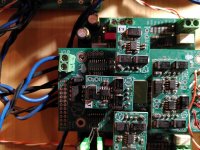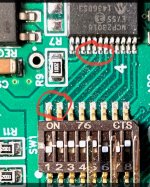Rus any updates re a Hermès v 2 ? As four channel use may not be that common I am thinking of using a second Hermès for isolating just the one extra signal. Would you anticipate any power issues and would you recommend grounding the four unused channel inputs or just let them float?
Hey everyone,
I decided to switch to an USB input through an Amanero-Hermes-Cronus to feed my BuffaloIIIsePro38. Unfortunately, after connceting everything as described in the first post I get no sound and the lock led of the Buffalo shows no light. So, here are a couple of questions:
1) I ordered the Amanero from TP. Does it already have the right firmware and configuration (slave mode) to run it with the Hermes and Cronus?
2) I only have access to a Linux machine. Does the Amanero work out of the box with Linux or are there any known issues?
3) I attached a picture of my wiring of the Cronus and the Buffalo. Are there any obvious flaws?
4) Any advice what I could test to check the correct functionality of the Cronus? Anything I could measure? I already had problems to make it run with a BBB-Hermes combination and I start believing the problem might lay in the Cronus (Problems with BBB-Hermes-Cronus for Buffalo-IIIsePro38 build.)
5) Is it possible to shortwire the Cronus to check if everything else works fine?
Cheers
Had some time again to work on my Buffalo build and here goes the next chapter of my Odyssey...
Still, SPDIF input works fine. Then, I want to change switch 1 position 1 to Off to enable SERIAL(PCM/DSD). My switch 1 was broken from the beginning and I replaced it, but when I controlled it with a multimeter the contacts of position 1 where always connected no matter how the dip switch was placed. In my despair I even removed the switch again and the contacts of position 1 are still connected (my multimeter shows a connection). Also, SPIDF input still works indicating that position 1 is connected. That might have been my problem all along why SERIAL(PCM/DSD) never worked for me...
Is there a way how position 1 could be shortwired even without a switch? Is there another possibiliy to disable it and to switch from SPDIF to SERIAL(PCM/DSD)?
I am glad for any helpful comment.
Attachments
Hi,
after long time not using Amanero/Cronus I want to test it again.
What are the aktuell advises for Firmware settings? Mainly for playing also DSD64/128/256).
thx
Branko
after long time not using Amanero/Cronus I want to test it again.
What are the aktuell advises for Firmware settings? Mainly for playing also DSD64/128/256).
thx
Branko
Is there a way how position 1 could be shortwired even without a switch? Is there another possibiliy to disable it and to switch from SPDIF to SERIAL(PCM/DSD)?
I am glad for any helpful comment.
The switch circuit is on the top layer, and when a switch is 'on' it connects the MCP23018 i/o interface pin to ground. You want to look for any abnormal connection between the interface pin and ground, and the two areas I circled are probably most likely. Any excess or small blob of solder between pins and/or a pin mis-alignment could cause what you're seeing. If you suspect a short on the side of an interface pin you might try carefully cleaning between the pins, perhaps with an Xacto knife, etc...
[BTW, photo below is a screen shot from the very useful 'magnifying glass' utility in my iPhone - useful if you don't have a better way to scrutinize the surface of the board.]
Good luck!
Attachments
Have problems flashing firmware to amanero from twisted pear.
I have two amaneros (1 older one from Italy and 1 from TP). the one from TP is not working and therefore I tried to refresh firmware. I used oemtool 1.17 from amanero site.
Flashing seems to work. Bur the amanero is not workin if I replace the the working older one?
The configuration bits "write flash" show almost immediately "flashing done"? But how to prove if flashing really went well?
I have two amaneros (1 older one from Italy and 1 from TP). the one from TP is not working and therefore I tried to refresh firmware. I used oemtool 1.17 from amanero site.
Flashing seems to work. Bur the amanero is not workin if I replace the the working older one?
The configuration bits "write flash" show almost immediately "flashing done"? But how to prove if flashing really went well?
I get them from Italy, so there is no inherent difference in the boards. The flashing is usually instant. I don't know of a way to confirm the settings in the OEM tool.
Hi,
I am using Amanero/Hermes/Cronus with foobar under windows 10.
I can only get sound with PCM/DSD when “Default: Digital Output (Amanero Technologies USB Driver 1.0.67)” selected as output in foobar.
If “DSD : ASIO : DSD Transcoder (DoP/Native)” output selected, then no sound with DSD and PCM 352K is heavily distorted in right channel.
Amanero: CPLD: Slave_For_1080, firmware: 1096c
In foobar: foo_input_sacd 1.2.3 (Output Mode: DSD+PCM), foo_out_asio 2.1.2
DSD Transcoder 1.1.5 installed and “ASIO Combo 384 Driver” selected as “ASIO Device”.
How to set DoP properly? Could someone help me with this please?
I am using Amanero/Hermes/Cronus with foobar under windows 10.
I can only get sound with PCM/DSD when “Default: Digital Output (Amanero Technologies USB Driver 1.0.67)” selected as output in foobar.
If “DSD : ASIO : DSD Transcoder (DoP/Native)” output selected, then no sound with DSD and PCM 352K is heavily distorted in right channel.
Amanero: CPLD: Slave_For_1080, firmware: 1096c
In foobar: foo_input_sacd 1.2.3 (Output Mode: DSD+PCM), foo_out_asio 2.1.2
DSD Transcoder 1.1.5 installed and “ASIO Combo 384 Driver” selected as “ASIO Device”.
How to set DoP properly? Could someone help me with this please?
Last edited:
Thank you,I get them from Italy, so there is no inherent difference in the boards. The flashing is usually instant. I don't know of a way to confirm the settings in the OEM tool.
what CPLD and CPU version do you flash?
I have two stacks of amanero/hermes/cronus: 1 older with cronus v1.1 and older amanoero working well with b3pro.
1 newer with cronus v1.4. This newer stack ist not working (no look no sound)
So I tried to exchange parts in the older working stack: amanero is not working and cronus v1.4 is not working?
So I tried to flash this amanero with amanero oemtool 1.17: CPLD slave for 1080/CPU 1096c (first with Mac and virtual Maschine and second with old XP laptop). The process bars booth times say "done" an setting the configuration bits afterward say "Flash update" but the amanero seem not to work when I swap it for the "old" working amanero (this one I did flash with the same old XP laptop some years ago).
Regards
Branko
- Home
- More Vendors...
- Twisted Pear
- Introducing the Hermes-Amanero

